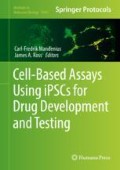Abstract
The cardiac action potential requires a precise timing of activation and inactivation of ion channel subtypes. Deviations, for example, due to blockage of specific voltage-gated potassium channels, can result in live-threatening arrhythmias. Due to the limitations of standard cellular assays based on cells which artificially express only single ion channel subtypes, many potentially interesting compounds are discarded during drug development. More predictive functional assays are required. With the upcoming of human stem-cell derived cardiomyocytes (hiPS-CM) these assays are available, supporting even the design of patient-derived disease models. Microelectrode array systems allow to noninvasively record and evaluate cardiac field action potentials. In this chapter we describe how to cultivate hiPS-CM on two parallelized MEA systems and suggest an experimental strategy for compound tests.
Access this chapter
Tax calculation will be finalised at checkout
Purchases are for personal use only
References
Gintant GA, Su Z, Martin RL, Cox BF (2006) Utility of hERG assays as surrogate markers of delayed cardiac repolarization and QT safety. Toxicol Pathol 34:81–90. https://doi.org/10.1080/01926230500431376
Antzelevitch C (2007) Ionic, molecular, and cellular bases of QT-interval prolongation and torsade de pointes. Europace 9(Suppl 4):iv4–i15. https://doi.org/10.1093/europace/eum166
Mitcheson JS, Chen J, Lin M et al (2000) A structural basis for drug-induced long QT syndrome. Proc Natl Acad Sci U S A 97:12329
Morissette P, Hreiche R, Turgeon J (2005) Drug-induced long QT syndrome and torsade de pointes. Can J Cardiol 21:857–864
Stett A, Egert U, Guenther E et al (2003) Biological application of microelectrode arrays in drug discovery and basic research. Anal Bioanal Chem 377:486–495. https://doi.org/10.1007/s00216-003-2149-x
Kraushaar U, Buckenmaier S, Guenther E (2009) MEA-based biosensors to study cellular differentiation and integration. Tissue Eng Part A 15:726–726
Kraushaar U, Meyer T, Hess D et al (2011) Cardiac safety pharmacology: from human ether-a-gogo related gene channel block towards induced pluripotent stem cell based disease models. Expert Opin Drug Saf:1–14. https://doi.org/10.1517/14740338.2012.639358
Halbach M, Egert U, Hescheler J, Banach K (2003) Estimation of action potential changes from field potential recordings in multicellular mouse cardiac myocyte cultures. Cell Physiol Biochem 13:271–284. https://doi.org/10.1159/000074542
Millard D, Dang Q, Shi H et al (2018) Cross-site reliability of human induced pluripotent stem cell derived cardiomyocyte based safety assays using microelectrode arrays: results from a blinded CiPA pilot study. Toxicol Sci 164(2):550–562. https://doi.org/10.1093/toxsci/kfy110
Mulder P, de Korte T, Dragicevic E et al (2018) Predicting cardiac safety using human induced pluripotent stem cell-derived cardiomyocytes combined with multi-electrode array (MEA) technology: a conference report. J Pharmacol Toxicol Methods 91:36–42. https://doi.org/10.1016/j.vascn.2018.01.003
Nyquest H (1928) Certain topics in telegraph transmission theory. Transact Am Inst Electr Eng 47:617–644
Holt GR, Koch C (1999) Electrical interactions via the extracellular potential near cell bodies. J Comput Neurosci 6:169–184. https://doi.org/10.1023/A:1008832702585
Buzsáki G, Anastassiou CA, Koch C (2012) The origin of extracellular fields and currents—EEG, ECoG, LFP and spikes. Nat Rev Neurosci 13:407–420. https://doi.org/10.1038/nrn3241
Bowlby MR, Peri R, Zhang H, Dunlop J (2008) hERG (KCNH2 or Kv11.1) K+ channels: screening for cardiac arrhythmia risk. Curr Drug Metab 9:965–970
Joshi A, Dimino T, Vohra Y et al (2004) Preclinical strategies to assess QT liability and torsadogenic potential of new drugs: the role of experimental models. J Electrocardiol 37(Suppl):7–14
Acknowledgments
The research leading to these results has received support from the Innovative Medicines Initiative Joint Undertaking under (grant no. 115439), resources of which are composed of financial contribution from the European Union’s Seventh Framework Programme (FP7/2007–2013) and EFPIA companies. This publication reflects only the author’s views, and neither the IMI JU nor EFPIA nor the European Commission is liable for any use that may be made of the information contained therein.
Author information
Authors and Affiliations
Corresponding author
Editor information
Editors and Affiliations
Rights and permissions
Copyright information
© 2019 Springer Science+Business Media, LLC, part of Springer Nature
About this protocol
Cite this protocol
Kraushaar, U., Guenther, E. (2019). Assay Procedures for Compound Testing of hiPSC-Derived Cardiomyocytes Using Multiwell Microelectrode Arrays. In: Mandenius, CF., Ross, J. (eds) Cell-Based Assays Using iPSCs for Drug Development and Testing. Methods in Molecular Biology, vol 1994. Humana, New York, NY. https://doi.org/10.1007/978-1-4939-9477-9_18
Download citation
DOI: https://doi.org/10.1007/978-1-4939-9477-9_18
Published:
Publisher Name: Humana, New York, NY
Print ISBN: 978-1-4939-9476-2
Online ISBN: 978-1-4939-9477-9
eBook Packages: Springer Protocols

